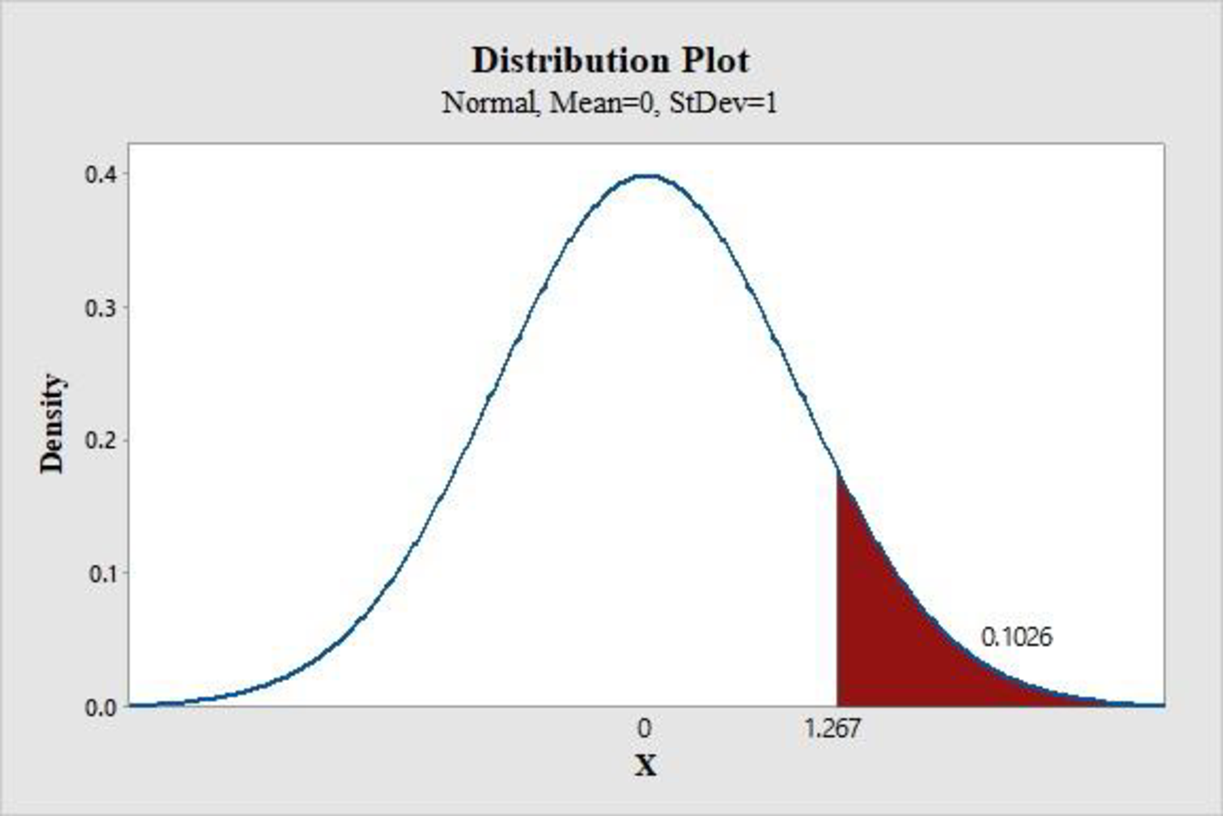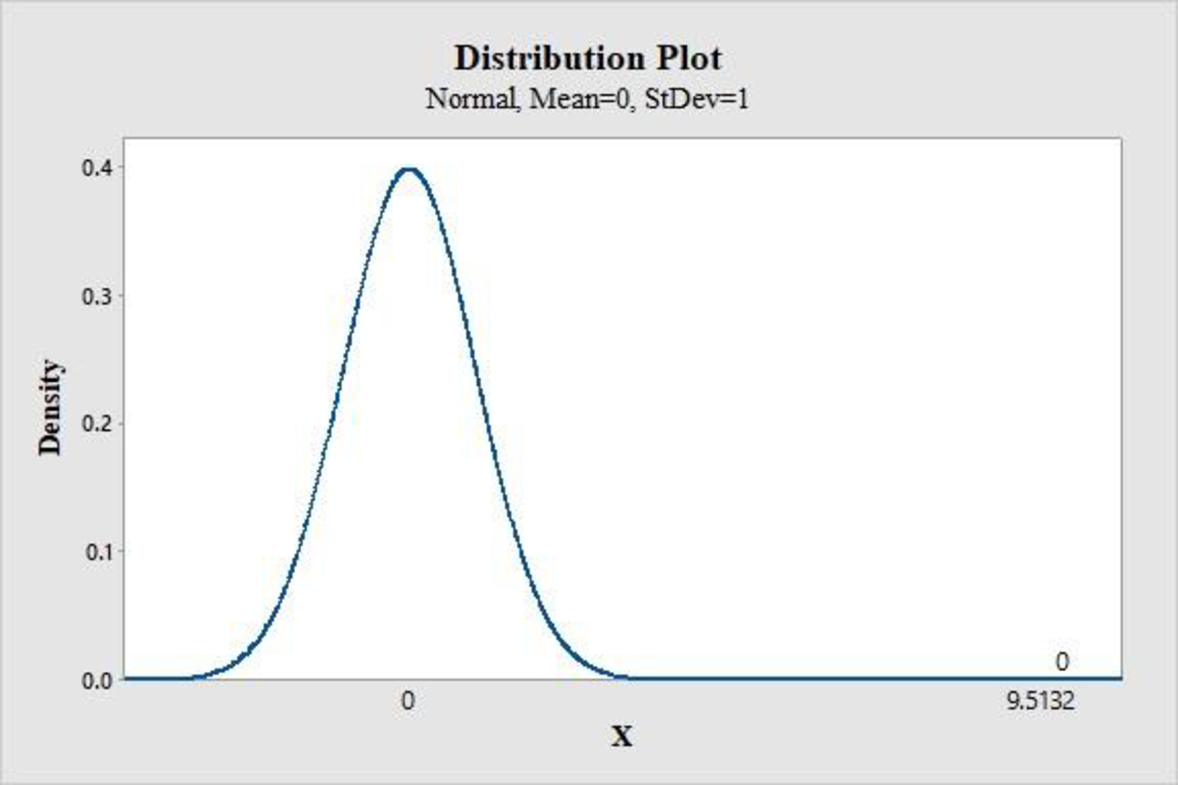
Concept explainers
a.
Estimate the proportion of adults who view a landline phone as a necessity using 95% confidence interval.
a.
Answer to Problem 5CRE
The 95% confidence interval of the proportion of adults who view a landline phone as a necessity is (0.6511, 0.7089).
Explanation of Solution
It is given that out of 1,003 adults, 68% thought a landline phone was a necessity.
Here, the
Conditions for 95% confidence interval:
1. Values of nˆp and n(1−ˆp):
nˆp=1,003(0.68)=682.04n(1−ˆp)=1,003(1−0.68)=320.96
Since nˆp and n(1−ˆp) are greater than 10, the sample size is large enough to proceed.
2. The sample size n=1,003 is much smaller than 10% of the number of adults (population size).
3. Since it is given that the survey is nationally representative, it is reasonable to assume the sample as a random sample from the population of adults.
Calculation:
The 95% confidence interval for p is given below.
ˆp±1.96√ˆp(1−ˆp)n
Substitute the values of n and ˆp in confidence interval formula as shown below.
ˆp±1.96√ˆp(1−ˆp)n=0.68±1.96√0.68(1−0.68)1,003=0.68±(1.96×0.0147)=0.68±0.0289=(0.68−0.0289,0.68+0.0289)=(0.6511,0.7089)
Interpretation:
The 95% confidence interval of the proportion of adults who view a landline phone as a necessity is (0.6511, 0.7089). Therefore, one can be 95% confident that the proportion of all adults who view a landline phone as a necessity is between 0.6511 and 0.7089.
b.
Check whether there is any convincing evidence that a majority of adults view a television set as a necessity at 0.05 significance level.
b.
Answer to Problem 5CRE
There is no convincing evidence that a majority of adults consider a TV set as necessity.
Explanation of Solution
In order to test majority of adults view a television set as a necessity, population proportion test is appropriate.
The following nine steps carry out the test for proportions.
1. Population characteristic of interest:
Let p denotes the proportion of all adults who consider a TV set as necessity.
2. Null hypothesis:
H0:p=0.5
That is, the proportion of adults who view a television set as a necessity is 0.5.
3. Alternative hypothesis:
Ha:p>0.5
That is, the proportion of adults who view a television set as a necessity is greater than 0.5.
That is, majority of adults consider a TV set as necessity.
4. Significance level:
α=0.05
5. Test statistic:
z=ˆp−p√p(1−p)n=ˆp−0.5√0.5(1−0.5)1,003
6. Assumptions:
- Here, nˆp=501.5 (1,003 × 0.5) and n(1−ˆp)=501.5 (1,003 × (1−0.5)). Since, both values are greater than 10, the sample is large enough to proceed.
- The sample is nationally representative. Hence, the sample can be treated as a random sample from the population.
- The sample size of 1,003 is large enough. Hence, all assumptions satisfy to conduct large sample test.
7. Calculation:
It is given that 52% (= 0.52) said they viewed a television set as a necessity. Therefore, ˆp=0.52. Substitute the values in the test statistic formula as shown below.
z=0.52−0.5√0.5(1−0.5)1,003=0.020.01579=1.267
8. P-value:
Software procedure:
Step-by-step procedure to find P-value using MINITAB software:
- Select Graph > Probability Distribution Plots.
- Choose View Probability.
- In Distribution, select Normal under Distribution.
- In Shaded Area, choose Right tail and give X value as 1.267.
- Click OK.
The MINITAB output is as follows:

From the MINITAB output, the P-value is 0.1026.
9. Conclusion:
Decision Rule:
If P-value is less than significance level, reject H0.
Here the significance level is 0.05.
Hence, 0.103>0.05.
Since P-value is greater than 0.05, fail to reject the null hypothesis. Therefore, there is no convincing evidence that a majority of adults consider a TV set as necessity.
c.
Check whether there is any convincing evidence that the proportion of adults who regard a microwave oven as a necessity decreased between 2003 and 2009 at 0.01 significance level.
c.
Answer to Problem 5CRE
There is a convincing evidence that the proportion of adults who regarded a microwave oven as a necessity decreased between 2003 and 2009.
Explanation of Solution
In order to test the proportion of adults who regard a microwave oven as a necessity decreased between 2003 and 2009, population proportion test is appropriate.
The following nine steps carry out the test for proportions.
1. Population characteristic of interest:
Let p1 denotes the proportion of adults who regarded a microwave oven as a necessity in 2003 and p2 denotes the proportion of adults who regarded a microwave oven as a necessity in 2009.
2. Null hypothesis:
H0:p1−p2=0
That is, the proportions of adults who regarded a microwave oven as a necessity in 2003 and 2009 are equal.
3. Alternative hypothesis:
Ha:p1−p2>0
That is, the proportion of adults who regarded a microwave oven as a necessity in 2003 is greater than the proportion of adults who regarded a microwave oven as a necessity in 2009.
4. Significance level:
α=0.01
5. Test statistic:
z=ˆp1−ˆp2√ˆpc(1−ˆpc)n1+ˆpc(1−ˆpc)n2
Where, ˆpc is the combined estimate of common population proportion.
6. Assumptions:
Here, n1 is 1,003, n2 is 1,003, ˆp1 is 0.68, and ˆp2 is 0.47
n1ˆp1=1,003(0.68)=682.04n1(1−ˆp1)=1,003(1−0.68)=320.96
n2ˆp2=1,003(0.47)=471.41n2(1−ˆp2)=1,003(1−0.47)=531.59
- Since the values of n1ˆp1, n1(1−ˆp1), n2ˆp2, and n2(1−ˆp2) are greater than 10, the samples are large enough to proceed.
- Also, the sample is nationally representative. Hence, the samples can be treated as a random sample from the population.
- The sample size of 1,003 is large enough. Hence, all assumptions satisfy to conduct large sample test.
7. Calculation:
It is given that 68% of the 2003 sample regarded a microwave oven as a necessity and 47% of the 2009 sample regarded a microwave oven as a necessity.
ˆpc=n1ˆp1+n2ˆp2n1+n2=1,003(0.68)+1,003(0.47)1,003+1,003=1,153.452,006=0.575z=0.68−0.47√0.575(1−0.575)1,003+0.575(1−0.575)1,003=0.21√0.000244+0.000244=0.21√0.000487=0.210.022075=9.5132
8. P-value:
Software procedure:
Step-by-step procedure to find P-value using MINITAB software:
- Select Graph > Probability Distribution Plots.
- Choose View Probability.
- In Distribution, select Normal under Distribution.
- In Shaded Area, choose left tail and give X value as 9.5132.
- Click OK.
The MINITAB output is as follows:

From the MINITAB output, the P-value is 0.000.
9. Conclusion:
Decision Rule:
If P-value is less than significance level, reject H0. Otherwise, fail to reject H0.
Here, the significance level is 0.01.
Here, the P-value is less than the level of significance.
Hence, 0.000<0.01.
Since P-value is less than 0.01, reject the null hypothesis. Therefore, there is convincing evidence that the proportion of adults who regarded a microwave oven as a necessity decreased between 2003 and 2009.
Want to see more full solutions like this?
Chapter 13 Solutions
Introduction To Statistics And Data Analysis
- In a group of 40 people, 35% have never been abroad. Two people are selected at random without replacement and are asked about their past travel experience. a. Is this a binomial experiment? Why or why not? What is the probability that in a random sample of 2, no one has been abroad? b. What is the probability that in a random sample of 2, at least one has been abroad?arrow_forwardQuestions An insurance company's cumulative incurred claims for the last 5 accident years are given in the following table: Development Year Accident Year 0 2018 1 2 3 4 245 267 274 289 292 2019 255 276 288 294 2020 265 283 292 2021 263 278 2022 271 It can be assumed that claims are fully run off after 4 years. The premiums received for each year are: Accident Year Premium 2018 306 2019 312 2020 318 2021 326 2022 330 You do not need to make any allowance for inflation. 1. (a) Calculate the reserve at the end of 2022 using the basic chain ladder method. (b) Calculate the reserve at the end of 2022 using the Bornhuetter-Ferguson method. 2. Comment on the differences in the reserves produced by the methods in Part 1.arrow_forwardTo help consumers in purchasing a laptop computer, Consumer Reports calculates an overall test score for each computer tested based upon rating factors such as ergonomics, portability, performance, display, and battery life. Higher overall scores indicate better test results. The following data show the average retail price and the overall score for ten 13-inch models (Consumer Reports website, October 25, 2012). Brand & Model Price ($) Overall Score Samsung Ultrabook NP900X3C-A01US 1250 83 Apple MacBook Air MC965LL/A 1300 83 Apple MacBook Air MD231LL/A 1200 82 HP ENVY 13-2050nr Spectre XT 950 79 Sony VAIO SVS13112FXB 800 77 Acer Aspire S5-391-9880 Ultrabook 1200 74 Apple MacBook Pro MD101LL/A 1200 74 Apple MacBook Pro MD313LL/A 1000 73 Dell Inspiron I13Z-6591SLV 700 67 Samsung NP535U3C-A01US 600 63 a. Select a scatter diagram with price as the independent variable. b. What does the scatter diagram developed in part (a) indicate about the relationship…arrow_forward
- To the Internal Revenue Service, the reasonableness of total itemized deductions depends on the taxpayer’s adjusted gross income. Large deductions, which include charity and medical deductions, are more reasonable for taxpayers with large adjusted gross incomes. If a taxpayer claims larger than average itemized deductions for a given level of income, the chances of an IRS audit are increased. Data (in thousands of dollars) on adjusted gross income and the average or reasonable amount of itemized deductions follow. Adjusted Gross Income ($1000s) Reasonable Amount ofItemized Deductions ($1000s) 22 9.6 27 9.6 32 10.1 48 11.1 65 13.5 85 17.7 120 25.5 Compute b1 and b0 (to 4 decimals).b1 b0 Complete the estimated regression equation (to 2 decimals). = + x Predict a reasonable level of total itemized deductions for a taxpayer with an adjusted gross income of $52.5 thousand (to 2 decimals). thousand dollarsWhat is the value, in dollars, of…arrow_forwardK The mean height of women in a country (ages 20-29) is 63.7 inches. A random sample of 65 women in this age group is selected. What is the probability that the mean height for the sample is greater than 64 inches? Assume σ = 2.68. The probability that the mean height for the sample is greater than 64 inches is (Round to four decimal places as needed.)arrow_forwardIn a survey of a group of men, the heights in the 20-29 age group were normally distributed, with a mean of 69.6 inches and a standard deviation of 4.0 inches. A study participant is randomly selected. Complete parts (a) through (d) below. (a) Find the probability that a study participant has a height that is less than 68 inches. The probability that the study participant selected at random is less than 68 inches tall is 0.4. (Round to four decimal places as needed.) 20 2arrow_forward
- PEER REPLY 1: Choose a classmate's Main Post and review their decision making process. 1. Choose a risk level for each of the states of nature (assign a probability value to each). 2. Explain why each risk level is chosen. 3. Which alternative do you believe would be the best based on the maximum EMV? 4. Do you feel determining the expected value with perfect information (EVWPI) is worthwhile in this situation? Why or why not?arrow_forwardQuestions An insurance company's cumulative incurred claims for the last 5 accident years are given in the following table: Development Year Accident Year 0 2018 1 2 3 4 245 267 274 289 292 2019 255 276 288 294 2020 265 283 292 2021 263 278 2022 271 It can be assumed that claims are fully run off after 4 years. The premiums received for each year are: Accident Year Premium 2018 306 2019 312 2020 318 2021 326 2022 330 You do not need to make any allowance for inflation. 1. (a) Calculate the reserve at the end of 2022 using the basic chain ladder method. (b) Calculate the reserve at the end of 2022 using the Bornhuetter-Ferguson method. 2. Comment on the differences in the reserves produced by the methods in Part 1.arrow_forwardYou are provided with data that includes all 50 states of the United States. Your task is to draw a sample of: o 20 States using Random Sampling (2 points: 1 for random number generation; 1 for random sample) o 10 States using Systematic Sampling (4 points: 1 for random numbers generation; 1 for random sample different from the previous answer; 1 for correct K value calculation table; 1 for correct sample drawn by using systematic sampling) (For systematic sampling, do not use the original data directly. Instead, first randomize the data, and then use the randomized dataset to draw your sample. Furthermore, do not use the random list previously generated, instead, generate a new random sample for this part. For more details, please see the snapshot provided at the end.) Upload a Microsoft Excel file with two separate sheets. One sheet provides random sampling while the other provides systematic sampling. Excel snapshots that can help you in organizing columns are provided on the next…arrow_forward
- The population mean and standard deviation are given below. Find the required probability and determine whether the given sample mean would be considered unusual. For a sample of n = 65, find the probability of a sample mean being greater than 225 if μ = 224 and σ = 3.5. For a sample of n = 65, the probability of a sample mean being greater than 225 if μ=224 and σ = 3.5 is 0.0102 (Round to four decimal places as needed.)arrow_forward***Please do not just simply copy and paste the other solution for this problem posted on bartleby as that solution does not have all of the parts completed for this problem. Please answer this I will leave a like on the problem. The data needed to answer this question is given in the following link (file is on view only so if you would like to make a copy to make it easier for yourself feel free to do so) https://docs.google.com/spreadsheets/d/1aV5rsxdNjHnkeTkm5VqHzBXZgW-Ptbs3vqwk0SYiQPo/edit?usp=sharingarrow_forwardThe data needed to answer this question is given in the following link (file is on view only so if you would like to make a copy to make it easier for yourself feel free to do so) https://docs.google.com/spreadsheets/d/1aV5rsxdNjHnkeTkm5VqHzBXZgW-Ptbs3vqwk0SYiQPo/edit?usp=sharingarrow_forward
 Holt Mcdougal Larson Pre-algebra: Student Edition...AlgebraISBN:9780547587776Author:HOLT MCDOUGALPublisher:HOLT MCDOUGAL
Holt Mcdougal Larson Pre-algebra: Student Edition...AlgebraISBN:9780547587776Author:HOLT MCDOUGALPublisher:HOLT MCDOUGAL Glencoe Algebra 1, Student Edition, 9780079039897...AlgebraISBN:9780079039897Author:CarterPublisher:McGraw Hill
Glencoe Algebra 1, Student Edition, 9780079039897...AlgebraISBN:9780079039897Author:CarterPublisher:McGraw Hill College Algebra (MindTap Course List)AlgebraISBN:9781305652231Author:R. David Gustafson, Jeff HughesPublisher:Cengage Learning
College Algebra (MindTap Course List)AlgebraISBN:9781305652231Author:R. David Gustafson, Jeff HughesPublisher:Cengage Learning
 Big Ideas Math A Bridge To Success Algebra 1: Stu...AlgebraISBN:9781680331141Author:HOUGHTON MIFFLIN HARCOURTPublisher:Houghton Mifflin Harcourt
Big Ideas Math A Bridge To Success Algebra 1: Stu...AlgebraISBN:9781680331141Author:HOUGHTON MIFFLIN HARCOURTPublisher:Houghton Mifflin Harcourt





